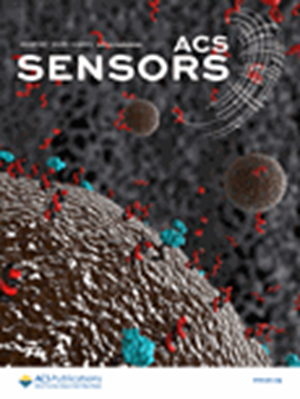通过调节查耳根取代共轭骨架合理设计两种兼容性良好的二聚受体,使三元有机太阳能电池的效率达到 19.4
IF 8.2
1区 化学
Q1 CHEMISTRY, ANALYTICAL
引用次数: 0
摘要
为了提高基于二聚受体(DMAs)的有机太阳能电池(OSCs)的性能,我们合理地开发了两种新的二聚受体,即 DC9-HD 和 DYSe-3,并将其用于制造三元有机太阳能电池。用硒原子取代 DC9-HD 熔合环核心外环上的硫原子后,产生了红移 DYSe-3。尽管存在这些细微差别,DC9-HD 和 DYSe-3 仍具有几乎相同的共轭骨架,这有助于它们形成相似的包装图案和结晶,最终使两种 DMA 具有高度的混溶性。将 DYSe-3 加入 PM6:DC9-HD 二元共混物中后,PM6:DC9-HD:DYSe-3 三元共混物中出现了直径≈16.9 纳米的纤维状形态,电荷重组现象也有所减少。更重要的是,由于其长激子扩散长度和低电压损耗,在开路电压和短路电流密度之间取得微妙平衡的同时,三元 OSC 还实现了 19.4% 的出色功率转换效率。这一超级成果与迄今为止报道的基于低聚物受体的 OSC 的最佳性能不相上下。此外,所提出的三元策略结合了一种聚合物供体和两种相容性良好的 DMA,不仅保留了 DMA 的优点,还为制造高性能三元 OSC 提供了一种简化方法。本文章由计算机程序翻译,如有差异,请以英文原文为准。
Rational Design of Two Well‐Compatible Dimeric Acceptors Through Regulating Chalcogen‐Substituted Conjugated Backbone Enable Ternary Organic Solar Cells with 19.4% Efficiency
To enhance the performance of dimeric acceptors (DMAs) based organic solar cells (OSCs), two new DMAs, designated as DC9‐HD and DYSe‐3, are rationally developed and employed to fabricate ternary OSCs. The substitution of the sulfur atom on the outer ring of the fused‐ring core of DC9‐HD with a selenium atom resultes in the red‐shifted DYSe‐3. Despite these minor differences, DC9‐HD and DYSe‐3 possess nearly identical conjugated skeletons, which contribute to their similar packing motifs and crystallinities, ultimately enabling a high degree of miscibility between two DMAs. Upon incorporating DYSe‐3 into the host PM6:DC9‐HD binary blend, fibril‐like morphologies featured with diameters of ≈16.9 nm and reduced charge recombination are observed in the PM6:DC9‐HD:DYSe‐3 ternary blend. More importantly, owing to their long exciton diffusion lengths and low voltage losses, a remarkable power conversion efficiency of 19.4% is achieved for the ternary OSCs, alongside a delicate balance between open‐circuit voltage and short‐circuit current density. This super result is comparable to the best performance of oligomer acceptor based OSCs reported to date. Furthermore, the proposed ternary strategy, which combines one polymer donor and two well‐compatible DMAs, not only retains the advantages of DMAs but also offers a streamlined approach for fabricating high‐performance ternary OSCs.
求助全文
通过发布文献求助,成功后即可免费获取论文全文。
去求助
来源期刊

ACS Sensors
Chemical Engineering-Bioengineering
CiteScore
14.50
自引率
3.40%
发文量
372
期刊介绍:
ACS Sensors is a peer-reviewed research journal that focuses on the dissemination of new and original knowledge in the field of sensor science, particularly those that selectively sense chemical or biological species or processes. The journal covers a broad range of topics, including but not limited to biosensors, chemical sensors, gas sensors, intracellular sensors, single molecule sensors, cell chips, and microfluidic devices. It aims to publish articles that address conceptual advances in sensing technology applicable to various types of analytes or application papers that report on the use of existing sensing concepts in new ways or for new analytes.
 求助内容:
求助内容: 应助结果提醒方式:
应助结果提醒方式:


